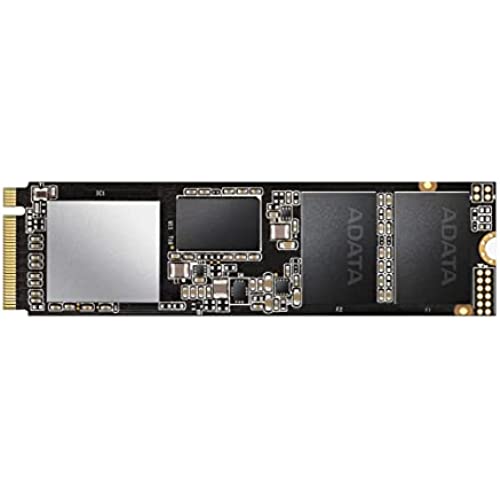
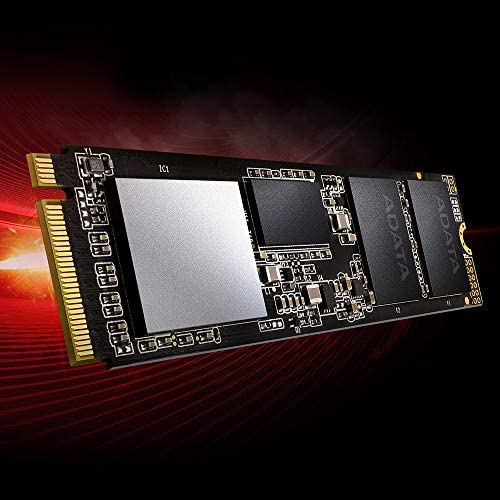
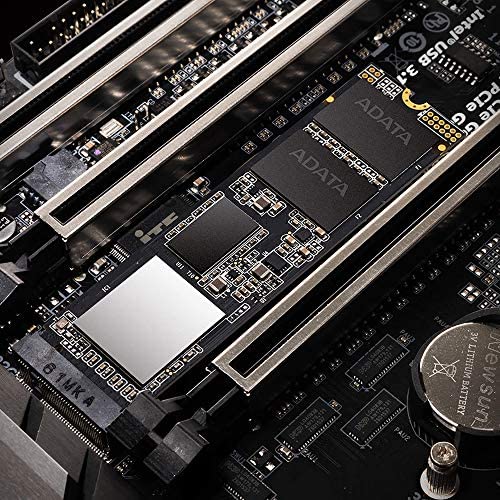
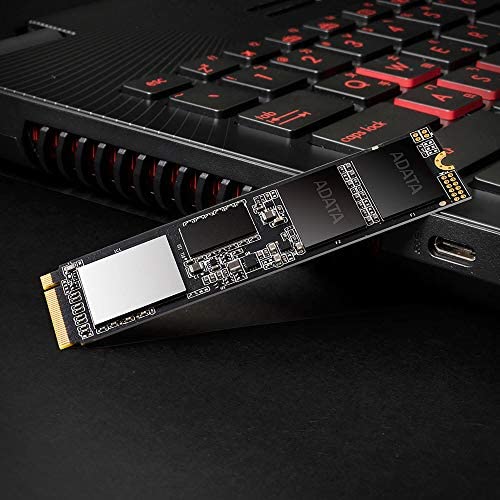
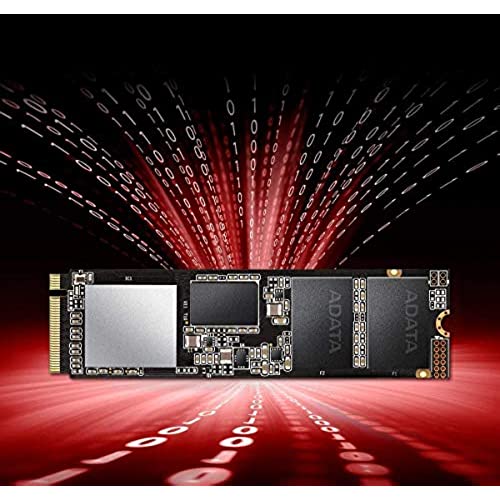
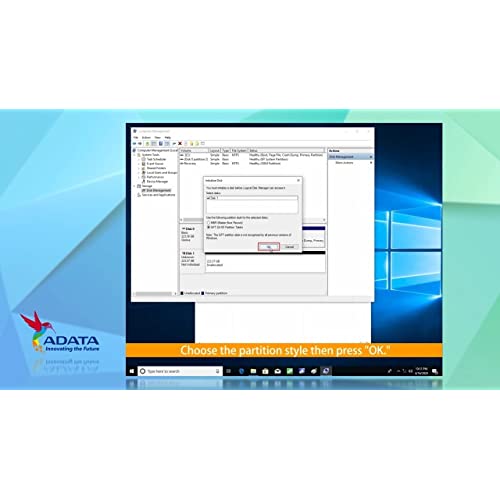






XPG SX8200 Pro 2TB 3D NAND NVMe Gen3x4 PCIe M.2 2280 Solid State Drive R/W 3500/3000MB/s SSD
-

MichaelS
> 3 daySo I saw a lot of people complaining that these dont perform as well as they review. While there might be some bad batches, you also need to realize that hardware types will limit the total speed. If your device only supports PCIe 2.0, which has a rating of 500MB/S per channel, and 4x you would get 2000MB/S total. So you cant get the 3500MB/S advertised. Youd max out at 2000. PCIe 3.0 can do 1000MB/S per channel, so you could max out the device at around 3350MB/S (the title says 3500, but when you see the comparison chart in the details it is a little lower). It depends on the motherboard and CPU for what is supported. NEXT! I just put together an x570 / Ryzen 3900x build. The board has two slots, so I started out with the bottom slot to get it away from the GPU hoping to cut down on heat (I have a metal heatsink on it). However, when I fired up Crystal disk mark on a fresh windows 10 install I noticed the speeds were much lower than advertised. There isnt much on the internet about this, but I found when a board has two m.2 drives it typically splits the bandwidth up. 4 PCIe lans from the CPU go to the primary slot, and 4 PCIe lans from the Chipset go to the secondary. What I realized is when I ran the drive off the chipset-based slot, it got much lower rates. When I moved it to the main slot, it got what it was rated for. Then I changed the setting in CrystalDiskmark to NVMe mode, and it went up a little more. You can see my comparisons in the pictures. Yes it does matter which slot it is in. So, if you are getting lower than rated specs check your supported PCIe version and the slot itself. Always use the CPU-based slot for the best performance(it would seem).
-

Jonathan Smith
> 3 dayIve upgraded from my Samsung 840 evo SSD to this Adata M2 as my boot drive. The speeds are a vast upgrade over the SSD topping out around 540 MB/s. Ive attached my personal benchmark after installing the drive fresh and cloning the drive. I would categorize these results as acceptable, close to the 3500 MB/s range. The Arconis tool you get is horribly outdated (2018 version), you must register your product with Adata then get the key etc. It was a pain in the butt honestly. Ive used Samsung and Seagate tools in the past that were just so much better. Anyways, it did the job. It made the recovery partition too large, so I had to fix it up with diskpart after. I didnt see any issues with packaging like some reviewers, looks like its straight from the manufacturer and not a refurb. Also, dont be a dope, and make sure you buy the tiny screws/mounts to install M2 drives if you dont have them. Dont knock this product for not having the included screws. This is the kit I got and it worked fine: https://www.amazon.com/gp/product/B07Q8THWZD/ref=ppx_yo_dt_b_asin_title_o00_s00?ie=UTF8&psc=1
-

SlowTarget
07-06-2025The drive was fairly easy to install. I had two issues. The first was that there was no mounting screw. It seems petty, but a 2mm screw is not easy to find and you cant install the drive with out it (Ace hardware). The second is that it wasnt super clear how to get the software needed to clone the existing hard drive, but a bit of digging got it done. Unfortunately, there was no warning about disabling the old drive on reboot. My first clone attempt failed, but after reading a ton of comments on the internet, I recloned the drive and after the automatic shutdown, I unplugged the old drive before rebooting. The new drive booted fine after that. I plugged the old drive back in, rebooted, set the boot order in the bios and all was well. After I confirmed that the new drive was functioning well, I was able to reformate the old drive for extra storage and backup space. With the new drive in place, my system is significantly faster. Yes the drive is faster, but because the PC was constantly accessing it, even simple operations were slower than they should have been. The PC is now a joy to use. Slugs like PhotoShop are quick loading and responsive too. It seems that my PC had a fast processor with enough ram, but the old hard drive was the bottleneck.
-

Keezopster
> 3 dayEvery new computer feels fast, but this upgrade really made a difference. Mostly, I wanted the extra size and felt like this particular model had the base price to storage space ratio. The only glitch with install would be trying to figure out how to put the heat spreader on it. That piece is optional and if you just look at the screw notch, its easy to figure out. Getting to the website to download the software needed to clone my old drive was a bit of a pain. Youll have to create an account, add lots of details about your new device, submit a proof of purchase, jump through six hoops of fire and wrestle three bears before you can gain access to this needed piece of software. I had an external case made for M.2 drives, which made things easier for me to clone my C drive to this new disc. However, if you dont have an extra space for an M.2 drive, youre going to have issues. Youll probably need to clone the original drive to something else and then clone it on to your new drive. Also, my old drive was half as big. The original clone used half of my new drive. I needed to watch a couple YouTube videos to figure out how to reclaim the extra space and make it whole. Not hard, but not for the faint of heart, either. Im subtracting one-star because of how many hoops I had to jump through to get the necessary cloning software.
-

Phish
> 3 dayI’ve been running with this ssd as my operating system for a little over 2 years now I’d say and it still boots up in under 13 seconds. Also I just recently stress tested it to see the speed and it was only off by 150 or so! Really impressed with the price, definitely recommend if you only need it for a OS drive
-

A.Smith Family
> 3 dayGreat value for money. Preforms as described has some neat toolbox you can download from the company. You get a nice little heat deflector that looks good check out the pic. Also you get a copy of Acronis if you register. Which is great and a very helpful tool for disc imaging and cloning. So if your in the market for an affordable 512gb this hasnt let me down go for it.
-

Kinomora
Greater than one weekUpgraded from a pretty cheap SSD which wasnt super fast or large. This M.2 SSD runs the NVMe protocol over PCIe 3.0 at x4 lanes. This is not a SATA M.2 drive. Not all motherboards provide M.2 NVMe SSD slots, make sure yours is compatible! Additionally, if you plan to install Windows (or any other OS for that matter) on this drive, check the manufacturers webpage or manual to validate whether or not it is capable of booting to an NVMe SSD in the first place. I installed this drive into my Biostar GT5 X370 Racing motherboard for AM4 with a Ryzen 2600. When loading into Windows still installed on my old drive, it was fine- detected right off the bat (you may need to open Disk Manager and initialize the disk before it shows in Explorer) and the speed at which it accepted and loaded files was amazing. My trouble came when trying to install Windows to it. At first I thought it would be a simple clone job, moving from one SSD to another- turns out, there are some BIOS settings that need to be changed. I spent nearly 3 days working through tutorials and guides trying to get this working, and Im not sure what combination of them caused it to finally work, but what seems to finally make it successful was disabling secure boot and disabling CSM in the bios, then inserting a windows installation USB drive, deleting the partition on the drive and formatting it, and finally allowing the installer to create the required 4 partitions for GMT. I now have Windows successfully installed on the drive and its amazing, really, if you dont have an SSD in your system youre missing it. I press the power button and as soon as the bios screen fades the desktop is already there. Applications load almost instantly, installations are lightning fast, this drive rivals the top of the line Samsung Evo and Pro SSDs in terms of speed, at half the cost. In highly recommend this to anyone looking to increase the performance of their system without breaking the bank.
-

EmbeddedFlyer
> 3 dayI have the 500GB and the 1TB versions of this drive and have personally bench marked both of them and theyre screaming fast. The 500GB drive blows away the more expensive 500GB Samsung Evo 970 Plus in sustained write performance. The more expensive Samsung can only sustain around 800 MB/sec while this drive does 2100 MB/sec or almost 3 times faster! They both can briefly write at over 3000 MB/sec but thats using the cache on the drive. Once the cache fills up (around 20GB - 30GB) the 500GB Samsung falls to around 800 MB/sec. The 1TB versions of both drives are even faster. To put this in perspective lets say you had 100GB of videos to copy or move to this drive. The Samsung EVO 970 Plus would take over 2 minutes while the XPG SX 8200 Pro would take only 48 seconds. While ADATA (XPG) doesnt have the reputation of Samsung, Intel or Crucial, theyre using among the best controller (Silicon Motion SM 2262EN) and flash chips (Intel/Micron) available in these drives. I also suspect the firmware is mostly from Silicon Motion. Incidentally, the HP EX950 SSD uses the same controller, same flash, and has very similar performance but generally costs more than the SX8200 Pro. These drives also have similar endurance ratings to the more expensive Samsung 970 Evo Plus. Time will tell if the XPG drives prove to be as reliable as most Samsung models from the past have. But in terms of price, specs, warranty, reviews, benchmarks, endurance, etc, this drive matches or beats Samsung in just about every category.
-

Aaron
> 3 dayI own the 1TB model and also the 512TB model and I plan to buy more for my upcoming builds. I have had zero problems with either of the drives. Here are the most important things I have learned in the process: 1.) Do *NOT* set your BLCK to anything other than 100MHz after installing any (not just this brand/model) M.2 drive; it will mess your drive installation up. 2.) Do not download or use XPGs version of Acronis. 3.) XPG also offers Macrium Reflect with these drives. Do download/use this software. It not only does it make cloning easy and painless, but it is a full featured software for backing up and restoring. Unlike other free softwares with drives, it does not restrict you to a drive that you bought; it will backup or restore any drive in the installed system. Especially with the 512GB drive, this is an amazing value. I paid $70 for the 512 GB drive, and the regular full version of Macrium Reflect costs about that much. To access the download, go to Adatas site (not XPG), and look for the link to Valuable software. It is something like consumer->support->download->valuable software. Not easy to find. 4.) The heatsink that comes with this drive is useless (except cosmetically). However, this drive does not really need a heatsink; it is very power efficient. 5.) If you cant find the M.2 screw in your motherboard box, look on the board itself; that is where I found mine. If you cant find it in either place, you are going to need to order a screw kit. You may want to check this before ordering any M.2 drive as none of them come with the screw. 6.) Use a magnetic screwdriver while installing your M.2 drive. You will be sorry if you dont. 7.) I got slightly better drive performance after adjusting my ring bus ratio. YMMV. 8.) There are very few ways that the speed of this drive can be felt as compared to a SATA SSD, but 3000MB/s sounds awesome, huh? 9.) Having components on only one side makes these drives good for laptop use. Drives with components on both sides dont always fit. I hope this helps.
-

Steve Robbins
> 3 dayThe hardware is near flawless. The software, however has fatal flaws. First of all the software works only with Windows. If youre running Ubuntu Linux like I do, I guess they dont want to do business with you. Then when its time to download Acronis True Image for your Windows 10 installation because you bought it with the SSD, you find their instructions are plenty wonky. They ask for a validation code that just doesnt come with the SSD, saying that its on the sticker adhered to the product. It is not. The only thing on that label or the box labels was model number and serial number of the product. The photo they supplied as a guide clearly showed three numbers on the product. I sent photos of their sticker and box, along with screenshots of their instructions and asked how I was supposed to get the validation number to download and install Acronis True Image. They sent me a canned response telling me how to register for their website (which I clearly had already done) and how to register the product (which the photos I sent them but they hadnt bothered to look at clearly showed I had already done. I tried a second time. Heres the photos. Im registered on the AData website. My SSD is registered. You ask for a validation code, give me the photo of a sticker completely unlike the one that came on my SSD, which has only two numbers: model number and serial number. Please tell me what to do. They send me the same canned response not addressing my issue. One last try. Repeated myself, and expressed dissatisfaction with their customer service, which seems not to provide human responses. I asked what a perfect product is worth if customer service is terrible, cant they actually respond to my questions and allow me somehow to download and register Acronis True Image? I received a slightly different canned response without comment, which now showed that the validation number could be the serial number for certain unidentified instances. They had also changed the requirement that the validation number have a different number of digits than the serial number. I tried it, and finally, after three weeks, succeeded in downloading Acronis and registering it. Thats when I discovered that I didnt get Acronis True Image at all, but a small subset of the Acronis True Image tools. Why am I not surprised. As much as I like the hardware, AData gets not one more penny from me. Service after the sale truly sucks. What I I had been depending on Acronis True Image to clone a hard drive? I elected to go with a fresh install and saved two weeks! I totally rebuilt my system from scratch in two weeks less than it took AData to get me the tools that wouldnt have worked with Linux anyway. The hardware is great. Buy Acronis True Image if you have Windows. You wont be getting it from AData. If youre a Linux user, they have nothing for you. I suggest either building from a fresh install, a good idea once in awhile anyway, or using Back In Time, a free software obtainable in the Ubuntu repository.
